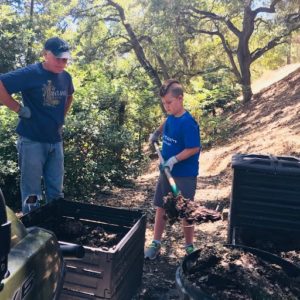by David George
I love to spend time in my substantial and challenging garden. The past twenty years, I have adopted natural (naked!), environmentally friendly gardening practices. As every gardener knows, a healthy garden begins with healthy soil. Composting is nature’s way of replacing nutrients your garden plants consume over time.
You may have read about the benefits of composting, but do you practice it? It’s so easy to stop by the local nursery and buy several expensive bags of compost to churn into your soil. But really, it is much easier to produce your own compost, and it’s less expensive. As a first step, you can request a plastic composting bin from your trash pick-up service. Many provide them at no cost. Others  credit a few dollars off each regular service bill. Online shopping sites advertise fancy composting systems, and they work faster than natural methods, but often at a much higher cost. Heck, how difficult is it to pile lawn clippings, plant trimmings, and dead leaves in the side yard? As long as you turn the material with a pitchfork and apply water occasionally, the material breaks down into rich compost over time.
credit a few dollars off each regular service bill. Online shopping sites advertise fancy composting systems, and they work faster than natural methods, but often at a much higher cost. Heck, how difficult is it to pile lawn clippings, plant trimmings, and dead leaves in the side yard? As long as you turn the material with a pitchfork and apply water occasionally, the material breaks down into rich compost over time.
Now that you have your own compost bin or heap, what do you put in it? Spent brown garden materials (dead leaves, branches, etc.) add carbon, and green materials (grass, fresh plant clippings, etc.) add a limited amount of nitrogen and other nutrients. If you add table scraps, egg shells, and coffee grounds into the mix, your mineral nutrient levels will soar. (Cover them with brown leaves to minimize smells and flying insects.) Meat scraps can even be composted. But all of our meat and seafood scraps end up inside our two big dogs.
Buy yourself a sturdy pitchfork. Turn your composting material every couple of months. Keep your materials moist but not soggy. Treat the task like you are cooking a three-layer soil cake. Every 4-6 months, depending on the warmth of the weather, transfer the top and middle layers of material to an empty trash bin. Harvest the lowest layer, which has naturally transformed into rich, new soil. Move that fresh compost to your neediest garden spot and turn it into the existing soil with a shovel. Transfer the top compost layers back into the bins for more cooking.
The next time you peek through your side fence and see fleshy, sun-starved parts of your neighbor as he turns the material in his compost bin, think of me – and celebrate the joy of natural gardening!

